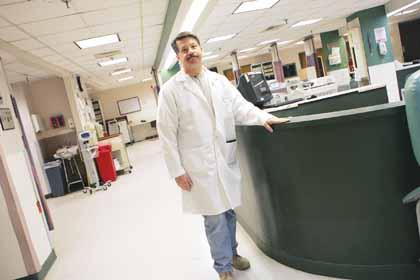By Stephen Stirling
When Borough President Helen Marshall toured the emergency rooms at Jamaica Hospital and Forest Hills Hospital last month, she was startled by what she saw.
“The whole floor was just people in those gurneys,” Marshall said. “They were packed together, one next to the other and all down the halls. There were at least 20 that were waiting to be admitted, but there were no beds. There was just no space.”
The scene Marshall described has become commonplace in Queens. In the wake of St. John’s and Mary Immaculate hospitals shutting down Feb. 28 after its management company, Caritas Health Care Inc., filed for bankruptcy, many of the borough’s 10 hospitals have been operating above capacity in what Marshall and hospital administrators have deemed a “public health crisis” in Queens.
“I would certainly call it that,” said Stephen Mills, CEO of New York Hospital Queens in Flushing. “This added pressure has been a difficult thing to deal with. Every hospital in the borough is feeling it. As it stands now, we have no ability in Queens to take care of a mass emergency situation. We just don’t have the capacity.”
Mills said New York Hospital Queens has seen 140 to 150 more patients a week coming through its emergency room.
“It’s not uncommon for a lot of those people to wait several hours to get a bed upstairs because there’s no room,” Mills said. “We’ve been on ambulance diversion more and more, but people end up coming here anyway because there’s nowhere else to go.”
The situation at New York Hospital Queens is by no means the exception to the rule.
At Jamaica Hospital, rising demand for equipment like heart monitors and a lack of bed space have forced the medical facility to scramble to place emergency supply orders and begin construction to add another 40 beds, but it has monitors on loan from vendors and is treating all patients as usual in a busier environment. At Elmhurst Hospital, spokeswoman Atiya Butler said the hospital has recorded a 20 percent increase in patients admitted since the beginning of March. Last week, Mount Sinai Hospital of Queens in Astoria received $1 million in state funding to hire additional staff after been flooded with additional patients from the Caritas closings.
“The depth and the scope of this is just amazing,” said Paola Miceli, director of health, human services and senior services for the borough president.
Marshall hosted meetings between state health-care officials, state Sen. Majority Leader Malcolm Smith (D-St. Albans) and Caritas leaders in January and February in hopes of saving the hospitals, which served about 200,000 patients annually, but ultimately a solution could not be found.
“It became very clear that the hospitals were not sustainable and it was not a viable organization,” said Ron Kim, Gov. David Paterson’s Queens County representative. “We didn’t have that kind of money to give. Every check that we gave them just went out the window because they had so much debt.”
Marshall said that although the Caritas board had taken steps to reduce their debt substantially since 2007, the state had been giving the facilities approximately $6 million every two weeks to keep them open.
“It was just too little too late,” Marshall said. “If the economic times weren’t so bad, I think they would have been saved.”
The closures left more than 2,900 hospital employees out of work, only a few hundred of whom have since been rehired elsewhere, according to 1199 SEIU, which represented most of the workers, and inquiries at borough hospitals.
According to statistics compiled by the borough president’s office, Queens — home to 2.2 million people — now has just 1.6 hospital beds per 1,000 residents, compared with Manhattan, which has 6.7 beds per thousand residents and a population of 1.6 million. Marshall says the county needs at least three more major health care facilities to be able to tread water as the borough’s population continues to grow.
“With Parkway [Hospital] closing last year and Mary Immaculate and St. John’s closing last month, we lost 650 beds,” she said. “We’ve got to say to ourselves, ‘What’re we going to do here?’ We’ve got to look at different ways of handling this situation.”
Marshall, who met last week with state Health Department Commissioner Dr. Richard Daines, said she plans on taking a lead role in seeking long-term solutions to the health care crisis in Queens and so far she has been encouraged by the response of the Queens hospital network.
“It’s one of the nicest things about all of this, the borough’s hospital network is really cohesive,” she said.
Mills agreed.
“The ideas have been on the table, I think it’s just a matter of taking action and doing it quickly,” he said.
Reach reporter Stephen Stirling by e-mail at sstirling@cnglocal.com or by phone at 718-229-0300, Ext. 138.



































